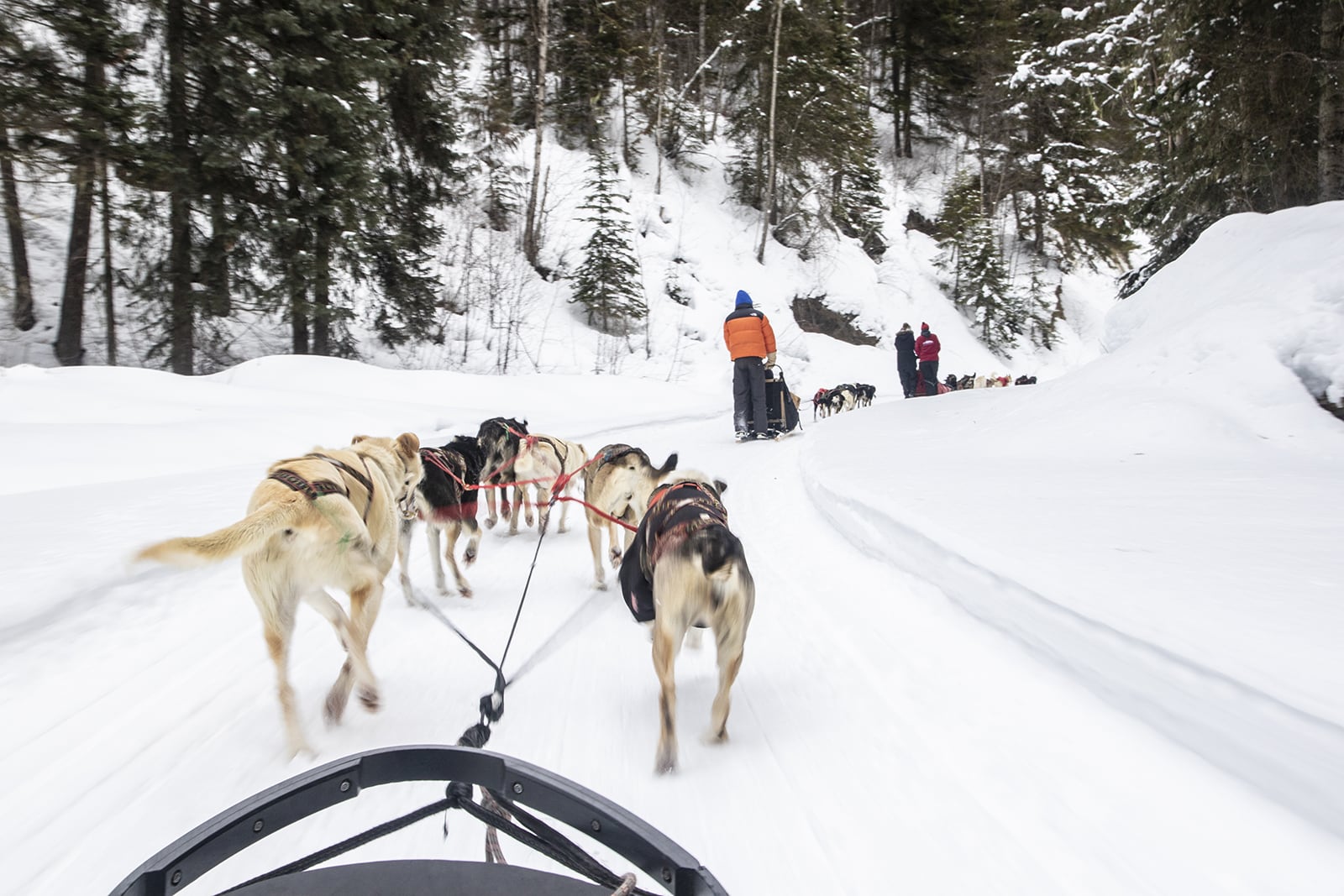The sound is mesmerising; the hiss of metal sliding along snow, the frenetic pitter-patter of 24 paws, the occasional bark mixed with a collective panting, a hum of wind in my ears, all balanced by a still larger sound of silence, emanating from the snow-draped valley we are moving through.
I am ensconced in a sled, relatively warm and with a massive grin on my face as myself and my co-pilot (standing behind me on the rear of the sled, taking his turn as driver) fly across a white landscape behind a team of six sled-dogs. We are moving through a remote valley about an hour’s drive west of Alberta’s adventure capital of Jasper.
It is February, and for this Australian having just come from a balmy Sydney summer, it is bloody cold (the temp hovers around 0 to 2 degrees Celsius). Even the chill of this winter’s day, though, can’t stop me smiling as I soak up the surrounding landscape, filled with ravines, frozen and semi-frozen creeks, and towering mountains in the distance.
I am also marvelling at how much sheer speed and grunt a team of six relatively diminutive Alaskan huskies can muster, whether ascending a rise, or punching down the other side. It’s nearing the end of a frantic five days on the ground in Jasper, exploring the many winter adventure activities it offers, and I can’t really see how it could have got any better. This morning’s mad charge through a relatively untouched land is proving me wrong, again. And I have no problem with that…
A quick adjustment
Jasper is well known for its excellent skiing during winter, but what is less well known is just how much richer this 5,500-strong mountain town is in terms of other adventure options for those who may want to either mix it up with their skiing or (like this writer) simply don’t ski.
Reaching Jasper takes a little bit of logistical planning, mostly centred around whether to jump aboard the Via Rail overnight sleeper train from Vancouver (with the chance to ogle the Rocky Mountains as you pass through) or my eventual choice of flying into Edmonton and linking a four-hour bus ride to Jasper.

It was while waiting for the bus that I copped my first taste of just how chilly Alberta can be. The week I was there I struck ‘perfect’ weather – a mix of sunny days at around 0 to 2 degrees Celsius, to night-time temps of -17 degrees Celsius. When I made a joking remark to the bus driver about it being a wee bit nippy, he just grinned and mentioned the -42-degree Celsius nights they’d experienced in January – I stopped even thinking to complain about being ‘a little cold’. And, truth be told, once in the winter sun – and appropriately rugged up – it was super nice.
Even nicer were my digs; the Fairmont Jasper Park Lodge (located inside the immense 10,878 square-kilometre Jasper National Park) is just east of town and is the ideal adventure basecamp if you’re not staying in Jasper itself. My cabin sat right opposite the frozen-over Lake Beauvert. I had a day to kick back before any adventure started so spent half of that exploring the lodge grounds and walking around the lake. The lodge has everything you’d need – restaurants, cafes, fat-bike hire, walking trails, bike trails, an ice-skating rink (in winter), canoe hire (summer, of course), and plenty more. In short, it’s nearly its own destination. I was, excuse the pun, warming up to a week here with little trouble…
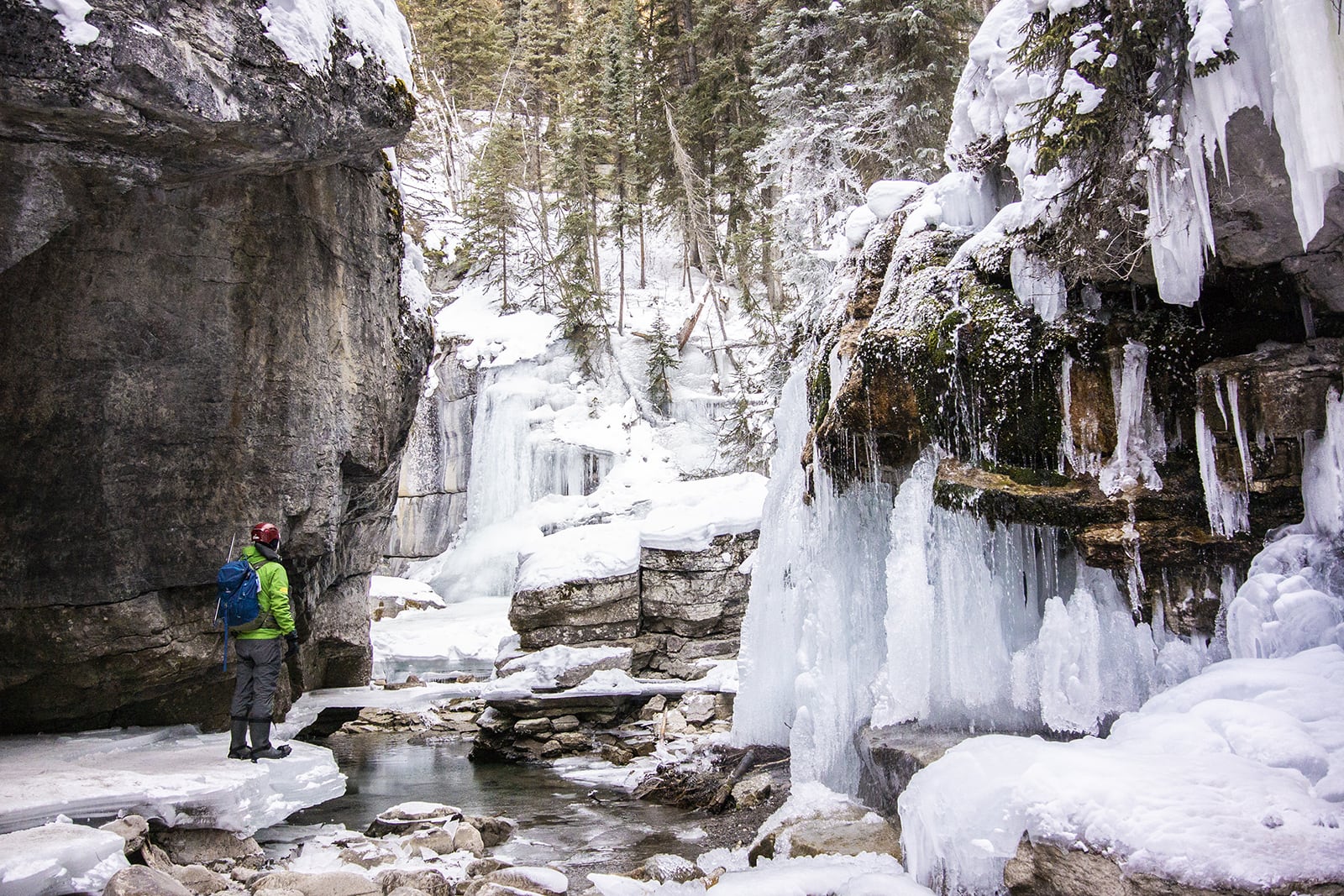
The ice world
Maligne Canyon is Jasper National Park’s deepest canyon, measuring as much as 50 metres in some sections. The canyon features Karst topography (the same as in the Nullarbor Plain, oddly enough) and the erosion that has created spectacular swirls and the smooth finish of its walls is the result of the eons-old flow of the Maligne River. In summer it is a fantastic walk, following the path of the river along the high-set walkway, traversing a number of bridges (you can do shorter walks to the second and third bridge or do what we did and walk to the sixth bridge – approximately 3.5km). I joined a SunDog Tours ice trek through the canyon. The advantage of winter and the ‘big freeze’ is that hikers can actually get down to the floor of the canyon at certain points. Another advantage of these conditions is the resultant ice-climbing opportunities dotted throughout the canyon, with the many frozen waterfalls offering climbs for all skill levels in a truly spectacular location. Hiking through the bottom of the canyon, with the towering, smooth-faced blue-tinged walls of it looming above, was a brilliant introduction to winter adventures here. The hike itself is not strenuous at all – it’d be perfectly suited to most age groups – and the tiny effort of doing it rewards you in spades in terms of immersing yourself in an otherworldly landscape.
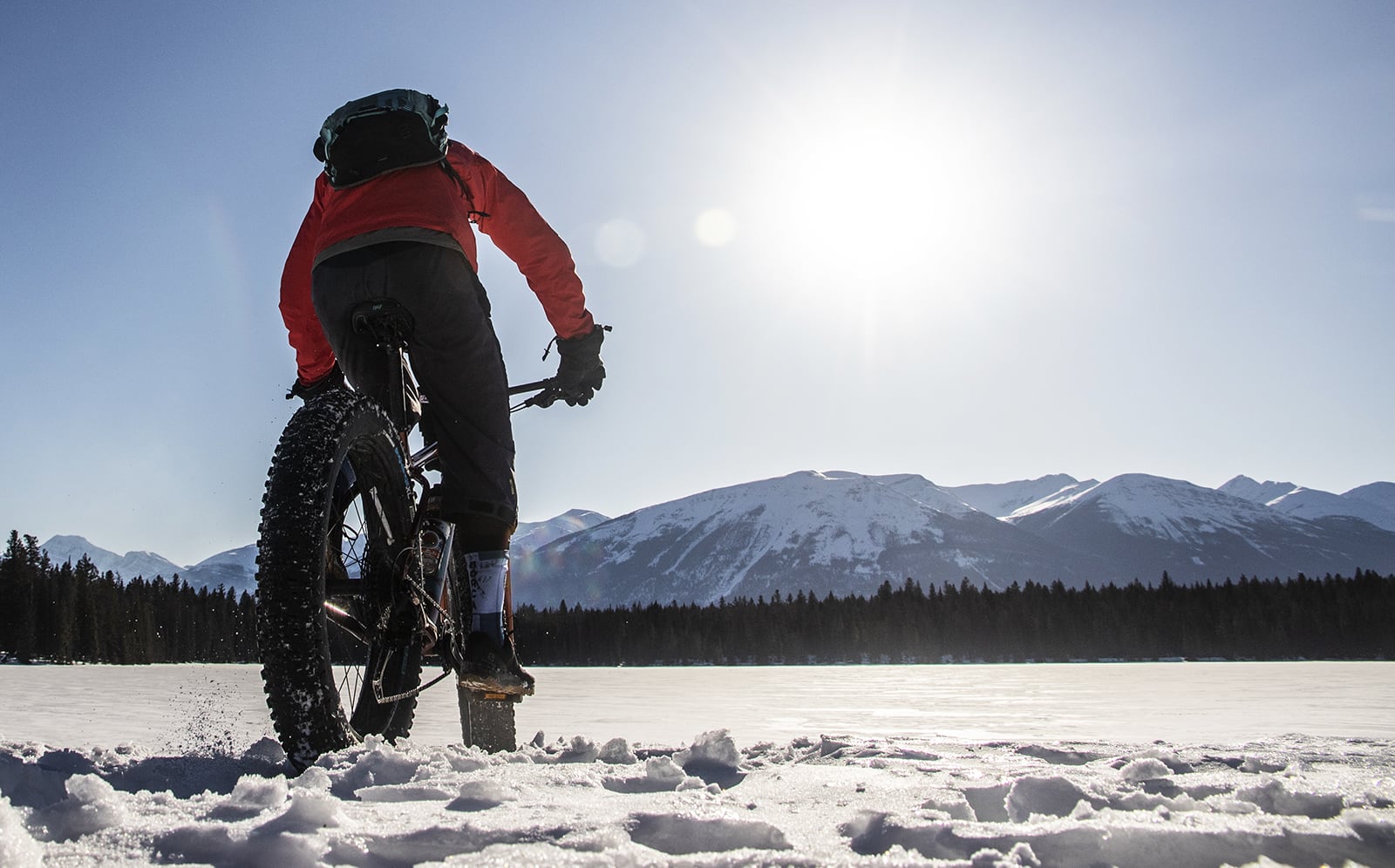
A floating sensation
It was with some slight trepidation that I rocked up to The Bench Bike Shop in Jasper the following morning, as ready as I could be for a morning fat-biking session. Not out of any fear of cycling, but just with a mind filled with questions of just how effective fat bikes would be on the snow that blanketed the whole region – and following on from that, just how much pain I was in for. Of course, I understood the theory; wide, big tyres running very low air pressures provide a big ‘bagged out’ footprint, allowing the tyre to spread out width- and length-wise to offer more contact with the ground surface, as well as offering more floatation, enabling the tyre (and consequently the rest of the bike and rider) to stay on top of the snow’s surface, not sinking in too much (or at all). This, in turn, would mean you could ride over said snowy surface without (hopefully) too much exertion.
Well, that was the theory, anyway, and it was one that I wasted little time in testing. After a quick g’day to The Bench Bike Shop owner, It was a quick hello to The Bench Bike Shop owner, Randal, and my guide for the day, Mike, before Mike and I were off, pedalling along Jasper’s main drag and heading toward some trails Mike had checked out earlier in the week.
If there was ever a perfect day to experience fat-biking on snow for the first time, this was it; the bluebird sky and bright sun, combined with the effort involved, soon saw us stripping off a few layers as we rode through some snow-drenched forest, on the way to a sweet trail that followed the bank of the pristine Athabasca River. Making it even easier to enjoy our surrounds was that the theory regarding fat bikes on snow was proving itself – and well; we made good, albeit bumpy, progress along some trails that walkers had already cut-in to the snow (there are no smooth groomed snow biking trails as yet in Jasper, but Mike said they are working toward making it happen) as we continued north-ish toward, firstly, Fairmont Jasper Park Lodge itself. After some photos, water and removal of a mid-layer, we continued further on, deeper into the national park, to the more remote Trefoil Lakes.
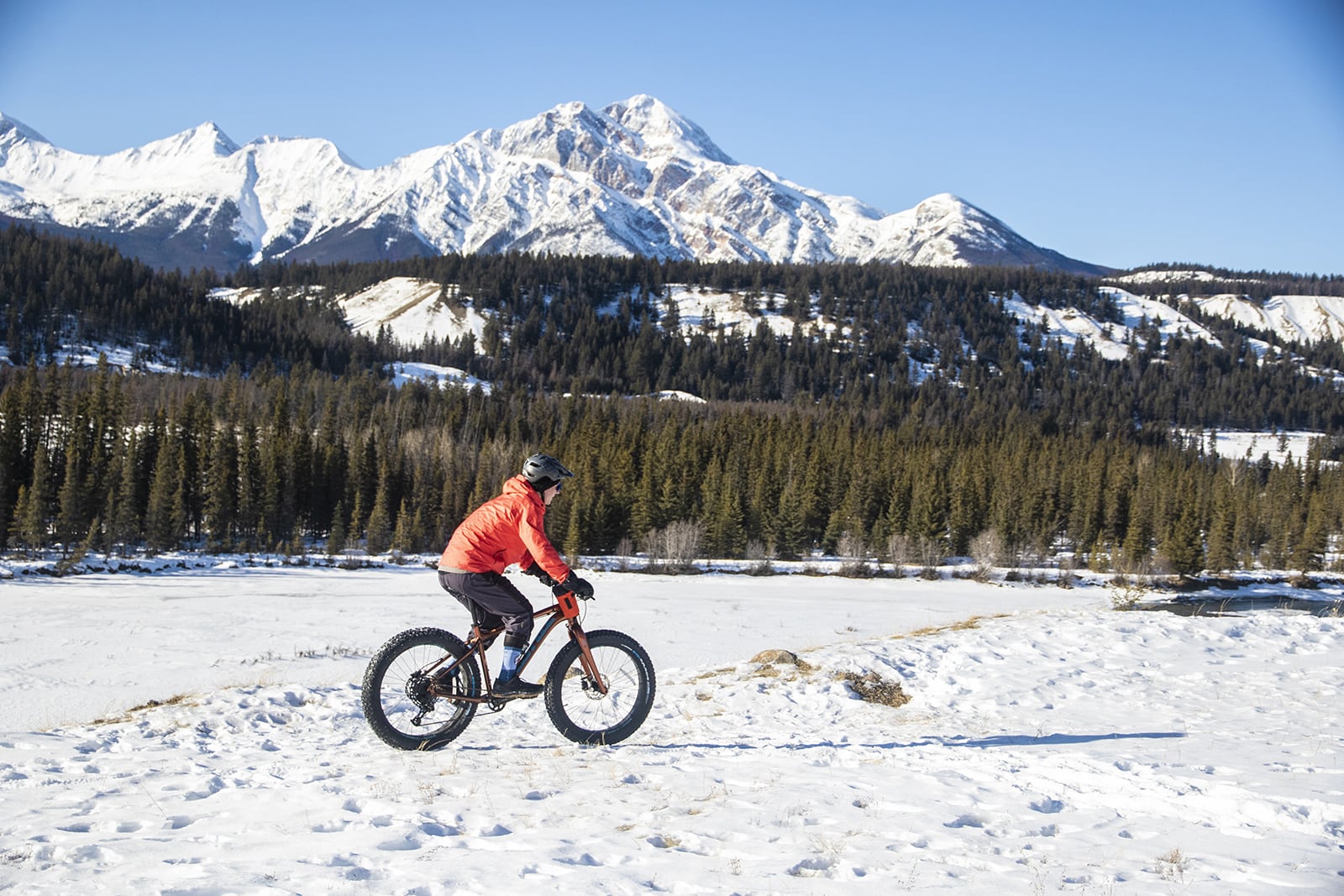
It was a sublime experience; the silence of the snow-shrouded forests was only broken by our (well, okay, my) heavy breathing and the steady thrum of tyre on snow, with those wide tyres keeping us up on top of the snow’s surface most of the time. The only hazard – and I got caught out a couple of times – was when we hit ice on the tracks at any angle other than straight-on; the tyres’ rubber just had no purchase whatsoever on the hard, smooth ice, providing a few humorous moments of falling off bikes at very slow speeds.
The relative ease with which we covered 15km made me think of just how much potential there was here for longer fat-bike-based adventures, with overnight (or longer) winter bikepacking expeditions a seeming no-brainer. As soon as they’re on offer, I will be one of the first to sign up.

Two wheels good, four paws faster
It’s all about teamwork apparently. This is something that myself and my sled co-driver, Oliver, soon find out after we start our dog-sled adventure with Cold Fire Creek Dogsledding. For sleds, the dogs are set up in three pairs, with each pair attached to a centre rope – a centre rope from which they are to stay on each side of. The dog teams are also set up according to performance: the most powerful are at the back, while the smartest and fastest are up front. The middle pair… well, in our team’s case, they just look like the canine version of a divorce, with plenty of bickering and sniping combined with the occasional nip at each other. With just two commands “Hike” to go and “Whoa” (along with a footbrake) to stop it shouldn’t be that hard, but after more than a few stop/start moments, one of our sled guides comes and removes one of the two offenders. After that, it is smooth – and fast – sailing.
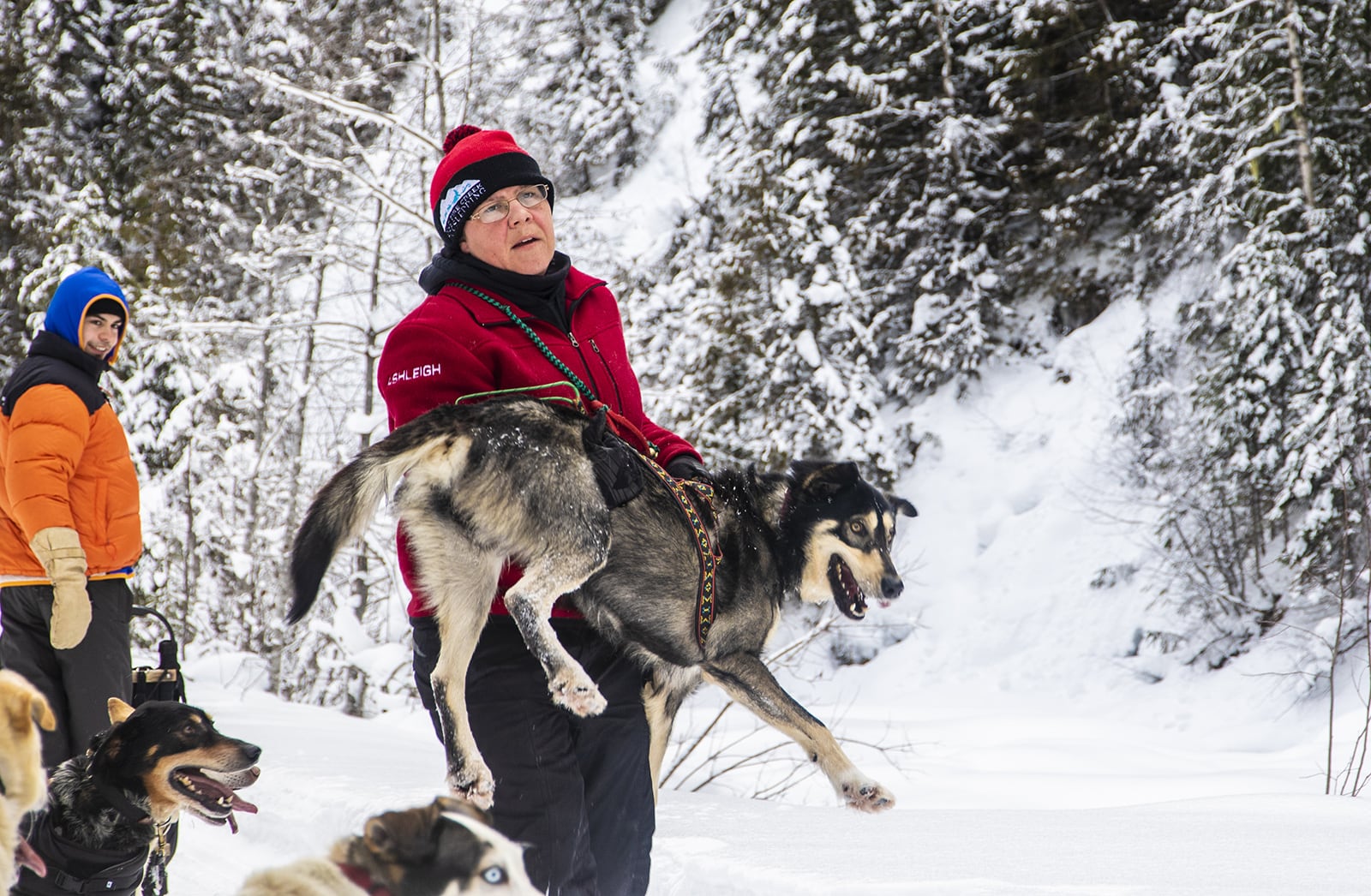
For those who envisage fluffy, big Siberian huskies as sled-dogs, our crew might disappoint. The ‘Alaskan husky’ is of a smaller size and variety of appearances (it’s actually a mixed-breed dog) are a world away from the Hollywood movie sled dog: they are lean, lithe and bloody fast. Siberian huskies are bigger and heavier, and thus slower, while these mini-tornadoes are – literally – jumping with the need to get moving ASAP. Cold Fire Creek Dogsledding’s Amanda says the dog teams run around 25km each day and the crew uses a rotating roster of up to 90 dogs to transport visitors into this remote winter wonderland.
The dogs’ need for constant speed is proven again by the fact that not only does each sled have a large brake, designed to cut into the snow to slow progress, but there’s also – yep, really – an anchor. Initially, I had an internal chuckle, but once I had to brake a sled, then try and keep it stationary while six hyperactive canines continued to want to push forward, I came to appreciate that anchor very much.
It’s an exhilarating feeling; being pulled along by six dogs at some considerable speed, through a remote valley is hard to describe. The sensation of speed feels weird, too, as there is no accompanying sound of a motor, tyres, or anything mechanical – it’s all natural, with just the wind on your face – and an absolute hoot because of it.
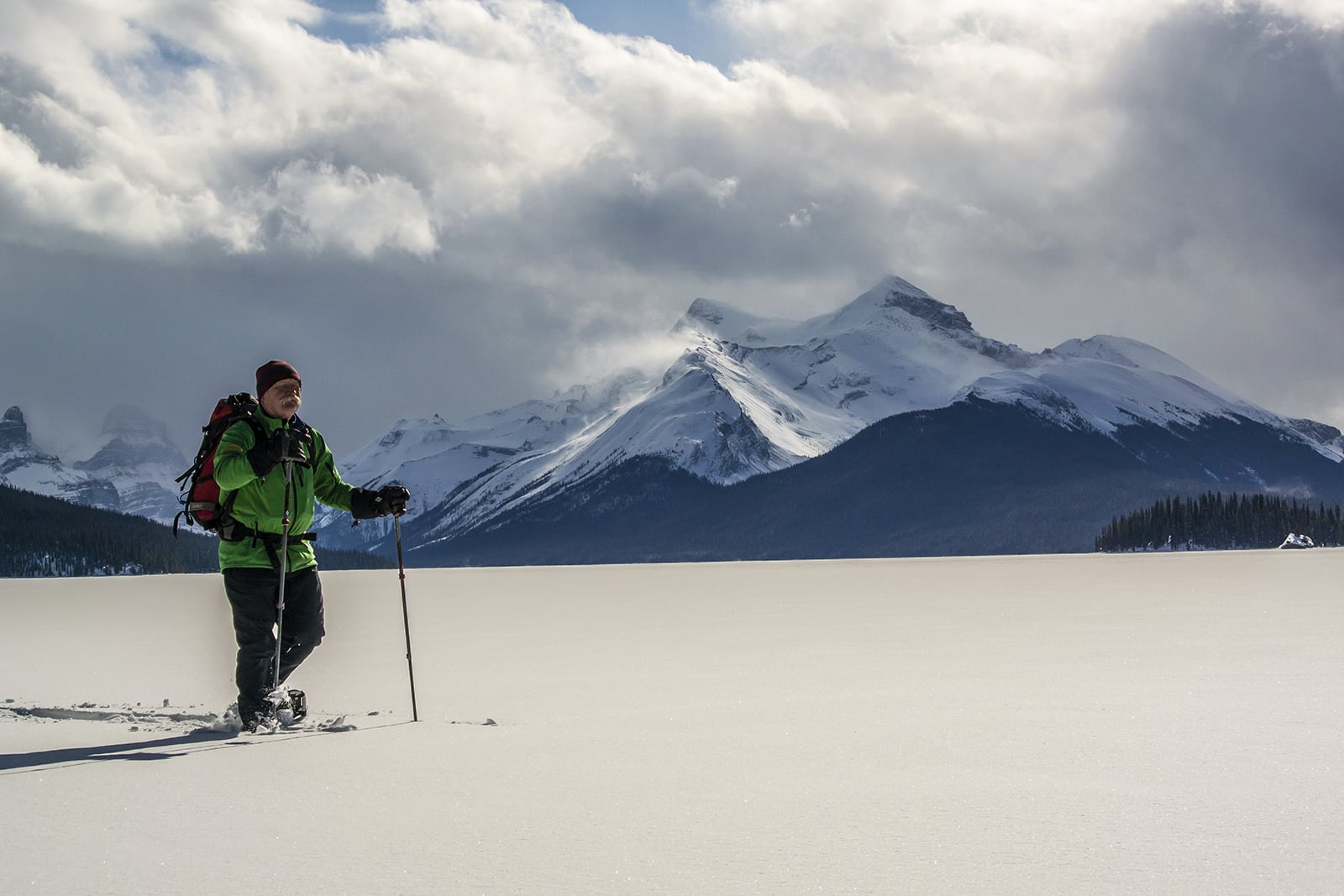
The long farewell
I am slicing through the snow in snowshoes, taking the ‘easy way out’ by following in the tracks of SunDog Tours Guide Wes, a former Parks & Wildlife ranger (he worked for National Parks for 37 years) who now takes visitors on trips into Jasper National Park. We are snow-shoeing across the frozen Maligne Lake. It’s actually a bit difficult for me to wrap my head around the fact we’re walking on frozen lake, due mainly to the fact that Maligne Lake is massive – at a touch over 22km long and with an average depth of around 35 metres – but even that size doesn’t stop the mighty Canadian winter from freezing the whole thing completely. As I take step after step, my mind still can’t comprehend just how cold it must get – and for how long – for a body of water of this size to freeze over.
Silence is the catch-cry here at Maligne Lake. Besides Wes’s many talks about the national park, the landscape, and the wildlife that thrives in the winter here (he really is a walking encyclopaedia – which is simply awesome), the sense of eternal space created by the massive lake and the equally sizeable mountains surrounding it, seems to suck away any other sound. For anyone looking for a mental as well as physical escape, this lake and its surrounds – combined with the rhythmical sensation of snow-shoeing, are close to perfect.
It’s amazing how much distance Wes and I cover; me listening to this human guidebook, him walking at a constant pace, we’re soon well away from the lake carpark and any other sign of civilisation. We stop, briefly, for a drink of water and a removal of a layer of clothing (yep, it’s another bluebird day) and it is now, with just the two of us standing like two specks of dust on the frozen lake’s vast white moonscape, that I think to myself: what if we just keep walking – and then walk some more. That’s how ingrained this region’s abundance of winter adventures, combined with a strong sense of place, has already become in my mind, as it braces itself for the return to ‘normality’. It’d be hard to stop walking, too, and I wonder if I may never want to; at the end of these five days, standing in the middle of a wonderful nowhere, I can see all the reasons why.
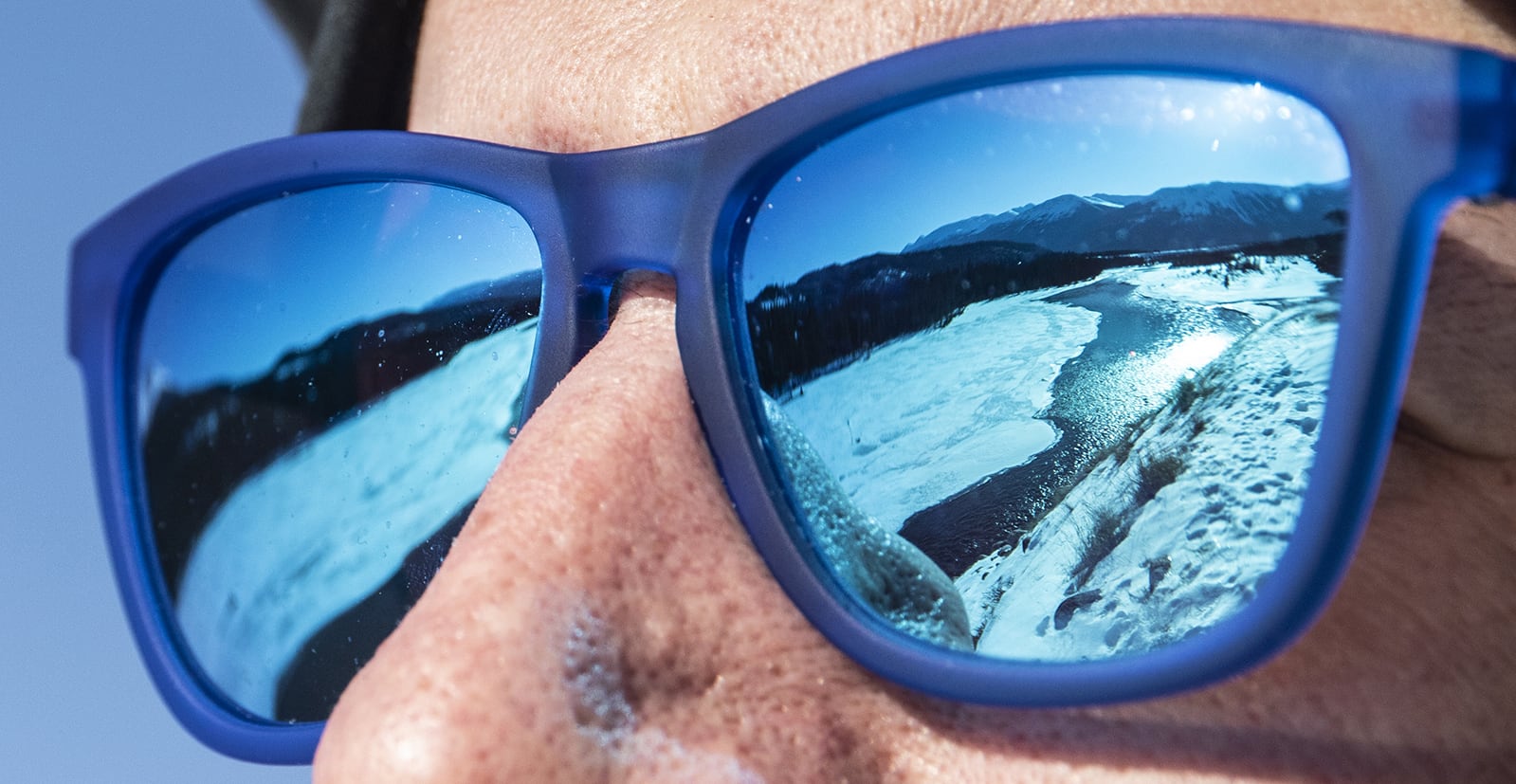
Getting there: Air Canada flies daily to Vancouver from Sydney and Brisbane. From Vancouver, you can catch a flight to Edmonton, Alberta or catch the Via Rail train to Jasper direct.
See www.aircanada.com and www.viarail.ca
Staying there: Fairmont Jasper Park Lodge offers a variety of accommodation and is only a 15-minute drive from town. It hires out canoes and bikes to visitors and has easily accessed walking trails. See www.fairmont.com/jasper/
Jasper itself offers a variety of accommodation, plus excellent eateries and a great craft brewing scene. See www.jasper.travel for more info.
Activities: SunDog Tours offers numerous outdoor and adventure activities in the Jasper region. See www.sundogtours.com
A dogsledding with Cold Fire Creek is a must. See www.dogsleddinginjasper.com
Skiing and ice-climbing are very popular. Rockaboo Mountain Adventures is the go-to for both. See www.rockaboo.ca
For all things Alberta, see www.travelalberta.com/au/
For Canada, see www.explorecanada.com.au
Thanks: The writer was a guest of Destination Canada and Jasper Tourism.
